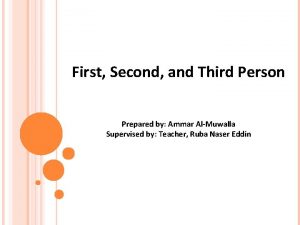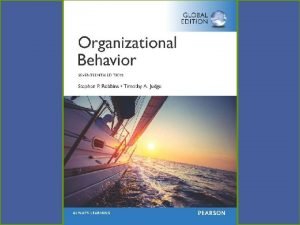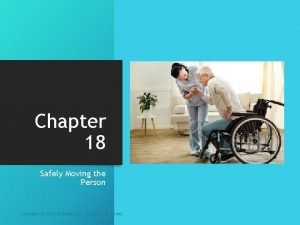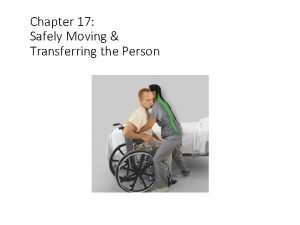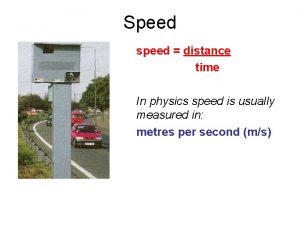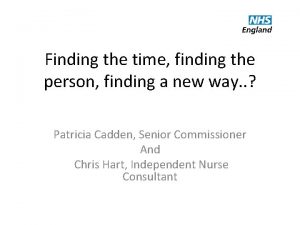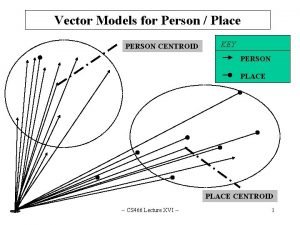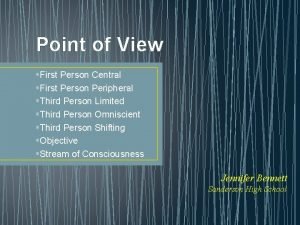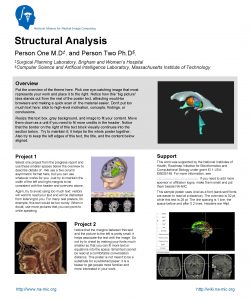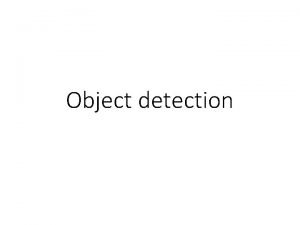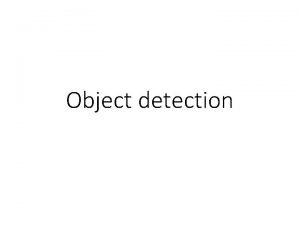Finding the time finding the person finding a












































- Slides: 44

Finding the time, finding the person, finding a new way. . ? Patricia Cadden, Senior Commissioner And Chris Hart, Independent Nurse Consultant

Been here before?

What we’ll be talking about • • • Introduction Reasons for commissioning the RDIC Custody Taking a moment The work to date Too busy, not enough staff, what to do? What next?

London deaths in prison custody/ detention 2013 -2016 12 10 8 2013 -14 2014 -15 6 2015 -16 2016 -17 4 2 0 Natural causes Self-inflicted Accidental (sus OD) Other Unknown at this point

2013 -2016 HMP WS HMP WW HMP PV HMP TS HMP BM HMP Isis √ Resuscitation and emergency response/roles √ √ √ Communication between doctors/nurses and prison staff √ √ √ Emergency response procedures √ √ √ ACCT management- healthcare input/recording √ √ √ Records management- meeting professional standards √ √ √ Assessment completion processes (clinical curiosity) √ √ Risk assessments- internal and for escorts out/on release √ √ √ Protocols for observations and escalation (recording of clinical measurements) Continuity of care (to and from community/hosp/court) √ Skill mix of staff in key areas √ Management of selfharm/suicide √ √ √ √ DNAR protocols- re: communicating to staff End of life care/pronouncement of death √ √ √ IRC HW √

Commissioning Chris • Observation- seeing healthcare teams/units at work • Processes- assessment/communication flows/staff support/ systems and governance • Identification- what are the actual issues? • Support- using his expertise and experience work with management and teams to agree change • Evaluate/sustain-what can be done to address cultural blocks/bring about a more dynamic workforce/new ways of working

Not taking the traditional route

Taking a moment

One I prepared earlier • Three little words: These were words written by participants before the group discussions took place so, hopefully, represented individuals’ own experience. • The largest number of comments reflected the difficulties, challenges and complexity of the work. • This was followed by comments about stress and pressure, the bureaucracy, and time and resources. • A number of individuals also identified anxiety and fear. • Frustration featured prominently, but also emotions such as guilt, failure, trauma and sadness. • Caring, the worthwhile nature of the work and the reward it brings also featured

The work to date – initial phase • • 3 day initial visit Introducing the process Talking with people – building relationships Observation of the detail of policy, practice and systems – To date: HMYOI Feltham, HMPs Wandsworth, Belmarsh and Thameside

Early findings – no surprises • Intense pressure on all staff arising from prison population and its needs • Difficulty balancing ‘security’ and ‘care’ • Complexity of healthcare provision • Difficulty integrating healthcare service into life of the prison • Difficulty maintaining systems

Extremely difficult for staff to see prisoner’s whole story and risk

How do we relate to the person?

How might ‘busyness’ affect us?

“No one cares”

“No one listens”

Yet…among the staff group • • • Resilience Perseverance Commitment Striving Compassion

Phase two • Designing bespoke developmental packages with staff from each individual service • Working with healthcare teams • Working with prison staff

Phase two • Providing resources • E. g. You. Tube films • Documents, presentations • Working alongside staff • Learning and developmental forums • Reflective practice sessions

Can we be paralysed by the problem of resources?

What do we mean by “short staffed”? • A commonly used term • What does it actually mean? – Insufficient numbers of people to carry out assigned tasks? – More work than we’ve previously had without an expansion in staff? – Fewer staff than previously available for the same amount of work? – A combination of the above?

What do we mean by “short staffed”? • Is it more about the ratio of staff to the amount of work to be undertaken? • Situation changes i. e. fewer staff, but do we adapt? • Some temporary measures but not moving into new mode of operation • Can feel like trench warfare rather than guerrilla warfare or trying to run a country estate on the budget for a semi detached semi.

“It’s all about management!” • Emotionally intelligent management • Inclusive • Incorporating methodology of shared governance • Focused on risk management and effective performance

Prioritising • What are the key problems we’re trying to solve/issues we’re trying to address? • What are the must dos (as opposed to what we always do)? • How was this decided? Does everyone know? Do they agree?

What cannot be done? • Do the right people know we won’t be doing certain things? • Do they understand, acknowledge and support this?

Team working • Who is in the team? Do they know they’re in the team? • What is the team’s focus? • What is their role? • Is this clear? • How collaborative is everyone? • What are my carrots?

Delegation • • • If someone has a task, are they ready for it? How do you/they know? What has been done to prepare them for it? Are we utilising people’s skills to the full? Have we got skills based training in place?

Communication • • What needs to be communicated? Who should do this? What systems are in place? How do people know what has happened on the previous shift, today’s priorities, who will be doing what and when?

Organisation • Do we work in a totally reactive environment • How do we plan ahead and try and stick to those plans [bearing in mind the best plans are those that never have to encounter ‘reality’]?

Not just what we can do differently but how?

Hope and ambition • Importance of hope • Limited ambition – sticking to achievable aims rather than leaving people feeling perpetually defeated e. g. “what have we achieved today and what can we achieve tomorrow? ”

The clinical picture

Clinical risk indicators for suicide • • • Previous self-harm Family history of suicide Previous use of violent methods Unemployed/retired Suicide plan/expressed intent Male gender Current suicidal thoughts/ideation Separated/widowed/divor ced Hopelessness/helplessnes s • • • Lack of social support Depression Family concerned about risk Evidence of psychosis Disengaged from services Alcohol and/or drug misuse Poor adherence to psychiatric treatment Chronic physical illness/pain Access to lethal means of harm

Other, specific, clinical factors in prisons • • • Previous trauma Lack of coping strategies Anxiety Poor physical health Recent stressors The prisoner might trivialise/conceal their risk indicators/vulnerability

Contextual risk factors • Predisposing factors e. g. – Previously in institutional ‘systems’ e. g. care as a child etc – The nature of the offence – Loss of support networks e. g. family relationships – Prisoners are isolated – Lack of contact with others • Bullying

The difference clinical curiosity can make

What can come from an extra few minutes

Clinical issues • Who assesses risk with people who don’t meet the defined criteria of existing teams? • Reception assessment is overly functional • How good are clinicians at engaging with people who say, “No” e. g. for assessment or meds? • How well prepared are clinicians for the work they need to do?

Security issues • Is a new approach needed for assessing and managing violence - ? an equivalent of the ACCT process? • Expanded role of the Officer • Less time for relationship building • Responding to behavioural strategies rather than unexpressed need • Make more use of targeted interventions to reduce the ‘temperature’ on the wing/house block

Systems issues (1) • Fragmentation – Prison and healthcare – Different healthcare providers – Gaps in healthcare provision e. g. dual diagnosis • But also in initiatives for developing/improving services

Systems issues (2) • More time required for assessing and managing complex cases • ‘Checklists and systems rule’ - reconnect with the interpersonal • Tracking and addressing DNAs and reasons for these • Review DIC reports and benchmark current service provision against recommendations

Development issues • Working with people with personality disorders • Mental health awareness • Updating the approach to ACCT reviews • Adapting ‘Every Contact Matters’ to incorporate risk • Reflective practice – we don’t learn through experience but by reflecting on experience

Marginal gains • Concept of “The aggregation of marginal gains” – Dave Brailsford • 1% improvements in small things accumulating, over time, into significant change

The flip side • How many lives are saved, each day, how many people are gently nudged away from the trajectory towards either harming themselves or others, by the small things Officers and clinicians do, the extra minute spent with them, the simple kindness, the referral, asking those key questions: • “What do you need? ” • “What can I do to help you? ”
 2 person singular
2 person singular First person you
First person you Person person = new person()
Person person = new person() Example of personal pronoun
Example of personal pronoun What is elapsed time
What is elapsed time Japanese 5 line poem
Japanese 5 line poem Is we third person writing
Is we third person writing First person vs third person writing
First person vs third person writing Person-job fit and person-organization fit
Person-job fit and person-organization fit Montag external conflict with society
Montag external conflict with society Private string
Private string When a person is logrolled the person is
When a person is logrolled the person is Features of a biography
Features of a biography One person's garbage is another person's treasure
One person's garbage is another person's treasure When moving a person in segments what do you move first
When moving a person in segments what do you move first Theme of the lion and the mouse
Theme of the lion and the mouse Person a and person b
Person a and person b A person swings on a swing when the person sits still
A person swings on a swing when the person sits still Hi how are you what are you doing
Hi how are you what are you doing Speed time distance formula
Speed time distance formula Finding distance with acceleration and time
Finding distance with acceleration and time Person of the year time template
Person of the year time template Epidemiology person place time
Epidemiology person place time Hình ảnh bộ gõ cơ thể búng tay
Hình ảnh bộ gõ cơ thể búng tay Frameset trong html5
Frameset trong html5 Bổ thể
Bổ thể Tỉ lệ cơ thể trẻ em
Tỉ lệ cơ thể trẻ em Chó sói
Chó sói Thang điểm glasgow
Thang điểm glasgow Chúa yêu trần thế
Chúa yêu trần thế Các môn thể thao bắt đầu bằng tiếng đua
Các môn thể thao bắt đầu bằng tiếng đua Thế nào là hệ số cao nhất
Thế nào là hệ số cao nhất Các châu lục và đại dương trên thế giới
Các châu lục và đại dương trên thế giới Công thức tính độ biến thiên đông lượng
Công thức tính độ biến thiên đông lượng Trời xanh đây là của chúng ta thể thơ
Trời xanh đây là của chúng ta thể thơ Cách giải mật thư tọa độ
Cách giải mật thư tọa độ 101012 bằng
101012 bằng độ dài liên kết
độ dài liên kết Các châu lục và đại dương trên thế giới
Các châu lục và đại dương trên thế giới Thể thơ truyền thống
Thể thơ truyền thống Quá trình desamine hóa có thể tạo ra
Quá trình desamine hóa có thể tạo ra Một số thể thơ truyền thống
Một số thể thơ truyền thống Cái miệng bé xinh thế chỉ nói điều hay thôi
Cái miệng bé xinh thế chỉ nói điều hay thôi Vẽ hình chiếu vuông góc của vật thể sau
Vẽ hình chiếu vuông góc của vật thể sau Thế nào là sự mỏi cơ
Thế nào là sự mỏi cơ

